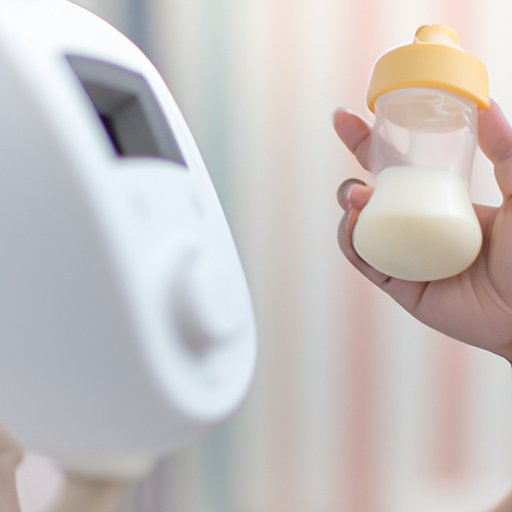
Introduction
For new mothers, the decision to breastfeed is a deeply personal one, but what about when a mother-to-be wants to continue pumping while pregnant? This controversial topic has received mixed success over the years, leaving many moms with questions about the benefits and risks of pumping while pregnant. In this article, we will explore the do’s and don’ts of pumping while pregnant, expert advice on the safety of the practice, benefits and risks, maintaining milk supply, and one mom’s personal experience.
The Do’s and Don’ts of Pumping While Pregnant: A Complete Guide for Moms-to-Be
Following guidelines for pumping during pregnancy is essential for moms-to-be to ensure they are not putting their baby’s health at risk. Here are the do’s and don’ts of pumping while pregnant:
DO:
- Consult with your doctor or healthcare provider before starting to pump while pregnant.
- Clean your pumping equipment regularly to avoid infection.
- Use the lowest possible suction level to avoid inducing labor.
- Pay attention to your body and stop pumping if you feel any discomfort.
DON’T:
- Pump more than necessary, especially during the third trimester when stimulation can trigger labor.
- Ignore any signs of discomfort, including nipple pain, breast tenderness, or uterine contractions.
- Assume that pumping while pregnant will increase your milk supply immediately. Wait until the second trimester before starting if your supply has stabilized.
It is essential to make pumping more comfortable during pregnancy by investing in a maternity bra that fits well without being too tight or constricting. Consider choosing a nursing pillow to support your back and arms during a lengthy pumping session.
Benefits and Risks of Breast Pumping During Pregnancy: What You Need to Know
Many pregnant moms opt to continue pumping for the benefits it provides; however, there are risks associated with pumping while pregnant. Here’s what moms-to-be need to know:
Benefits of pumping while pregnant:
- Continued production of breast milk throughout pregnancy
- Improved health for the newborn if born prematurely
- Less stress on the newborn if separated from the mother
Risks of pumping while pregnant:
- Inadvertently inducing labor or miscarriage in high-risk pregnancies
- Overstimulating the breasts, resulting in painful contractions and premature labor
- Changes to breast milk quality and quantity as pregnancy progresses
Factors that affect the benefits and risks of pumping during pregnancy include maternal age, gestational age, overall health, and the healthcare provider’s recommendation. It is important to weigh these factors carefully before deciding to continue pumping during pregnancy.
Expert Advice: Can You Safely Pump Breast Milk While Pregnant?
Experts have weighed in on the safety of pumping while pregnant. According to the American Pregnancy Association, it is safe to continue pumping while pregnant if done in moderation and following guidelines.
According to La Leche League, if a woman has a healthy pregnancy, there is no reason to avoid pumping or breastfeeding. Your breastfeeding journey is unique, and it’s best to consult with your healthcare provider about your individual circumstances.
Pumping While Pregnant: Tips and Tricks for Maintaining Milk Supply
Maintaining milk supply is essential for mothers who choose to pump while pregnant. Here are some strategies to help maintain milk supply:
- Continue to pump and breastfeed frequently
- Stay hydrated with plenty of fluids and nutrient-dense foods
- Avoid any sudden changes to your breastfeeding routine.
It’s important to find a balance between pumping and breastfeeding while pregnant. Most pregnant women produce enough milk to breastfeed, so there is no need to force milk supply if it’s not there.
A Personal Account: One Mom’s Experience With Pumping While Pregnant
Mia, a new mom, continued pumping while she was pregnant with her second child. She shared her experience:
“I chose to continue pumping while pregnant because it was essential for my son’s health. I followed all the guidelines of not overdoing it, cleaning the equipment regularly, and mentioning it to my doctor first. I was lucky that I had great support from my partner and healthcare team. I ended up pumping enough milk to freeze during the pregnancy, which gave me a lot of relief when I gave birth.”
Mia acknowledges that her experience and initial decision to continue pumping while pregnant were influenced by her healthcare provider’s recommendation and the needs of her baby. She understands that every pregnancy is unique, so what worked for her might not work for others, and she encourages moms-to-be to discuss their options with their healthcare provider.
Understanding the Physiology of Pumping Breast Milk During Pregnancy
Understanding the physiology of pumping while pregnant involves knowing how pregnancy affects breast milk production and how pumping affects milk production and composition.
During pregnancy, breast milk production may stop or decrease. This is due to the increased production of progesterone, which inhibits milk production. Pumping while pregnant may signal the body to increase milk production and prevent a decrease in milk supply.
Pumping while pregnant may lead to changes in milk composition, such as a decrease in fat content and an increase in protein and water, to meet the fetus’s nutritional needs.
Conclusion
In conclusion, pumping while pregnant is a personal decision that requires careful consideration of the benefits and risks. It’s essential to follow guidelines and consult with your healthcare provider. Remember that no two pregnancies are the same, so what works for one may not work for another.
Our hope is that this article provides you with valuable insights into the topic so that you can make an informed decision about whether to pump while pregnant or not.
As always, we encourage you to seek advice from your healthcare provider before making any decisions about your health and your baby.





